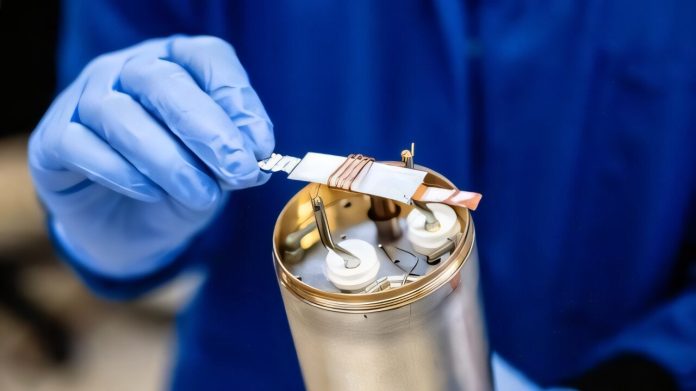
A team of scientists at the U.S. Department of Energy’s Argonne National Laboratory has developed a new way to study how batteries age over time.
They used a technique called nuclear magnetic resonance (NMR), which is also used in medical imaging, to watch what happens inside batteries as they work.
This method, the first of its kind, lets researchers see in fine detail how the chemistry of battery materials changes over years of use without taking the battery apart.
A recent study published in The Journal of Power Sources describes how Argonne researchers applied NMR to commercial pouch battery cells.
These are the same types of cells used in electric cars and many consumer electronics.
NMR works by applying a strong magnetic field to the battery and sending a radio-frequency signal. This causes certain atoms in the battery materials to absorb energy.
When the signal is turned off, the atoms release that energy, and researchers use this data to learn about the atomic structure and chemical reactions happening inside the battery.
With this new method, scientists can better understand how batteries with silicon anodes (the negative part of the battery) perform over long periods.
Silicon anodes are a promising alternative to traditional graphite anodes in lithium-ion batteries, as they can store more energy, which could allow electric vehicles to drive farther on a single charge. However, silicon has its challenges.
When lithium ions bond with silicon during charging, the anode expands by up to 400%. When the battery discharges, the lithium leaves, and the anode shrinks. This constant swelling and shrinking can cause the silicon anode to crack, limiting the battery’s lifespan.
To address this, Argonne’s researchers used NMR to study silicon anodes in action. They found that as the battery charged, many lithium atoms became trapped in the anode in the form of lithium silicides.
When the battery discharged, not all the lithium returned to the positive electrode, or cathode.
These trapped lithium atoms caused the battery’s energy capacity to slowly decrease over time. Furthermore, the lithium silicides reacted with the battery’s electrolyte, which further reduced its performance.
This new NMR technique is highly sensitive and can detect even light elements like lithium, silicon, carbon, and hydrogen—elements that are harder to study with other methods.
Since the NMR method is non-invasive and non-destructive, it allows researchers to observe the battery’s behavior under real-world conditions, something that previous aging experiments couldn’t do as effectively.
Unlike typical lab-made battery cells that can last only a few weeks, the cells used in this study are built to industrial standards, making them more durable and similar to the batteries found in electric vehicles and consumer devices.
Another key finding from the study was that adding a magnesium salt to the battery’s electrolyte helped reduce the amount of trapped lithium silicides. This could lead to new ways of designing batteries with better performance and longer life.
The NMR technique isn’t just limited to studying lithium-ion batteries with silicon anodes. It could also be used to study other emerging battery technologies, such as sodium-ion or solid-state batteries. Argonne scientists hope that their method will attract interest from battery manufacturers and researchers who want to improve the performance and longevity of their batteries.
By using NMR to study battery materials in detail, scientists can learn more about how to prevent the chemical changes that make batteries degrade over time. This could help create longer-lasting batteries for electric cars, renewable energy storage, and many other applications.



